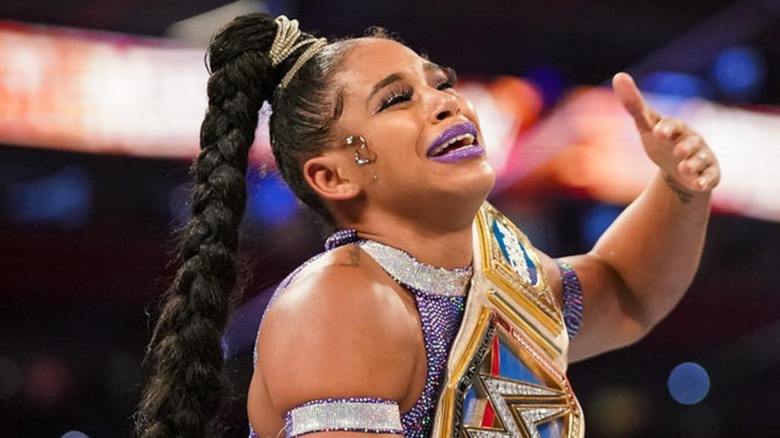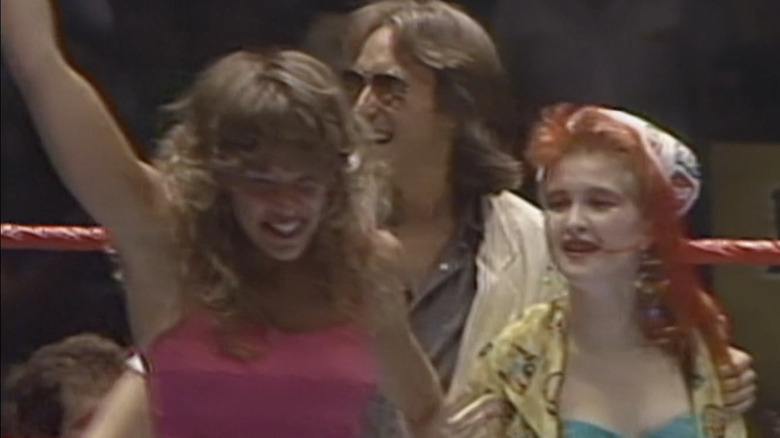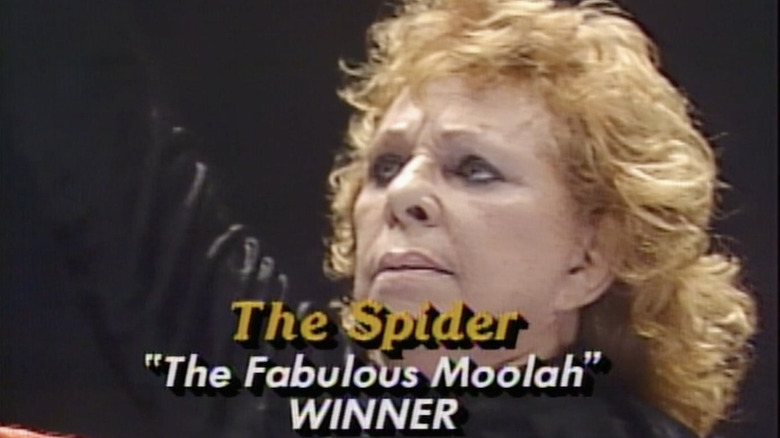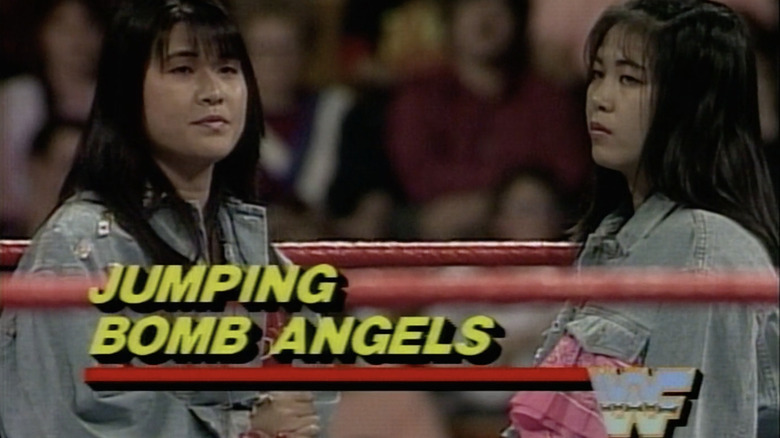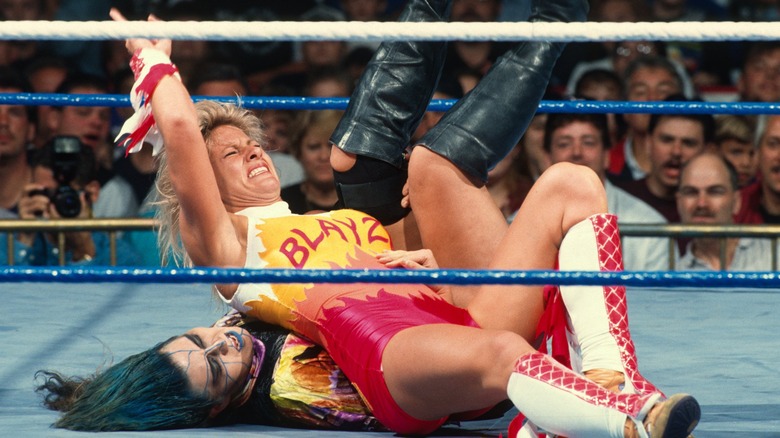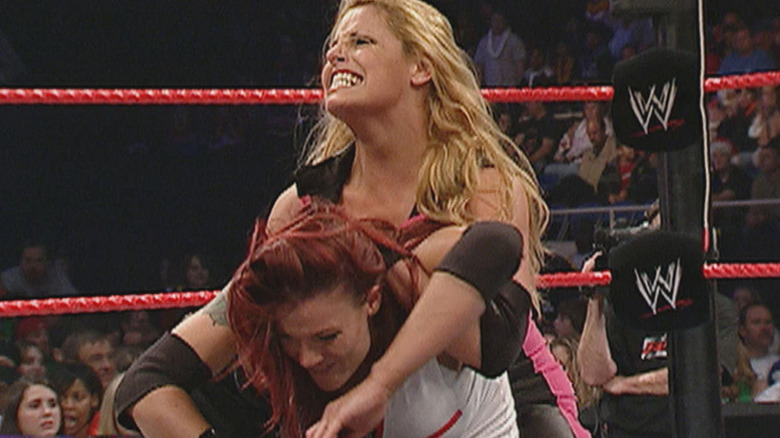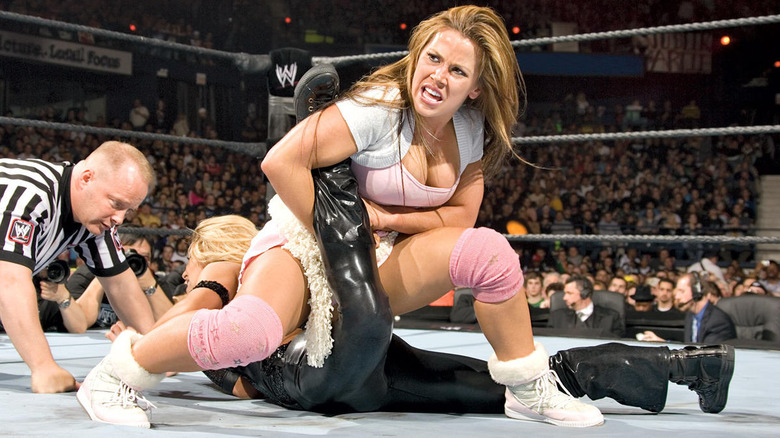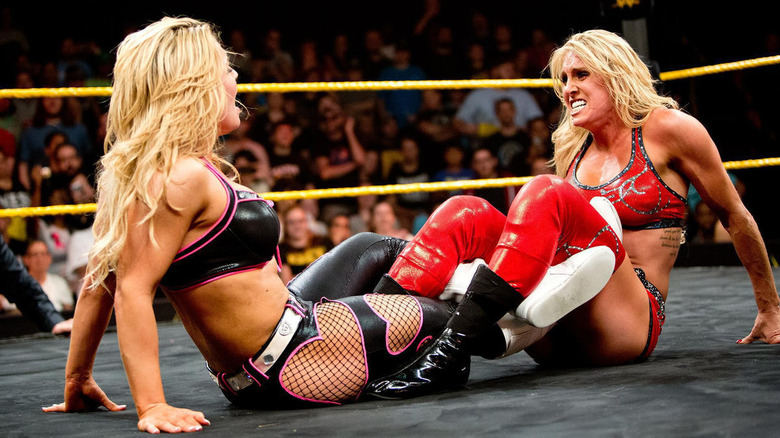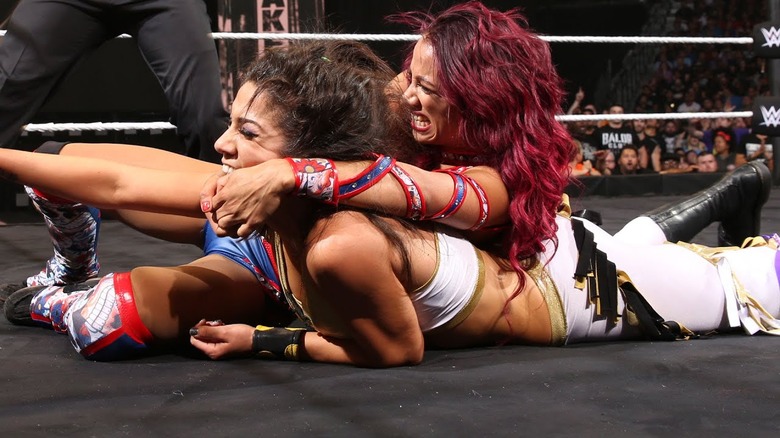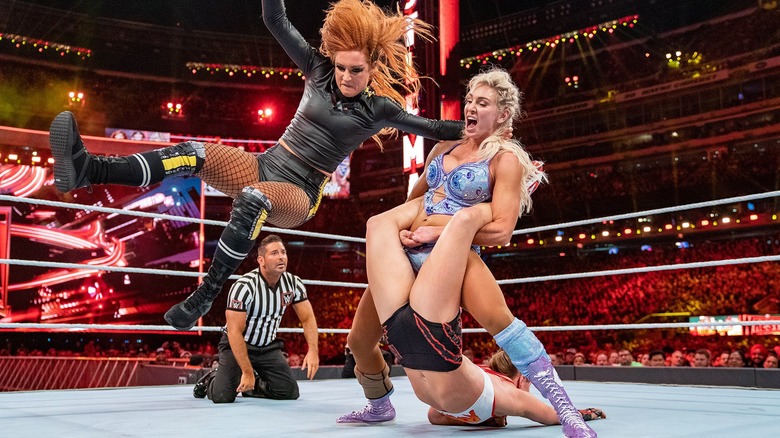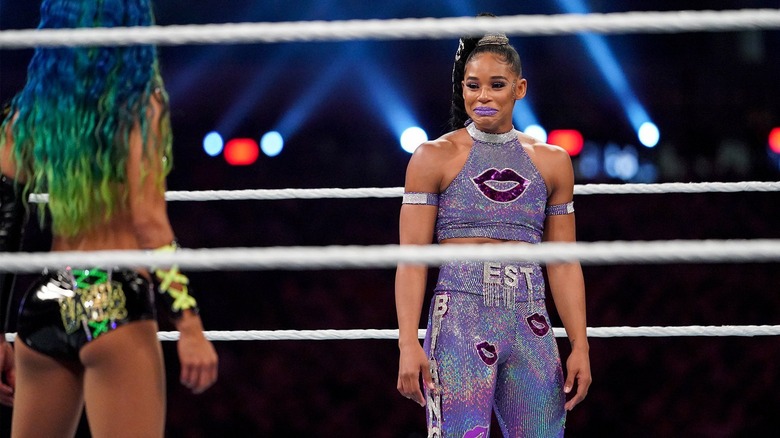The 10 Most Historic Women's Matches In WWE History
In the roughly four decades since WWE first instituted an official women's championship, the path of the division has been, at best, strange. There have been various starts and stops, with there only being a consistent division since late 1998. For much of its existence, it was treated as a sideshow to gawk at and not a serious concern at the level of the men's matches. There were experiments with women's wrestling at various points in the 1980s and 1990s, but they rarely involved a fully-functioning women's division. Instead, the "division" was usually the champion and whoever her touring challenger was at the moment.
A more functional division didn't mean much, as far as WWE progressing with the times, though. It wasn't until deep into the 2010s that WWE started presenting the women in ways even remotely comparable to the men, and it only happened once fan demand for such a change was ridiculously obvious. With that in mind, let's take a look at the most historically important WWE women's matches that got us where we are now.
Wendi Richter's title win over Fabulous Moolah with Cyndi Lauper in her corner airs on MTV (7/23/1984)
For decades leading into 1984, American women's wrestling had, unfortunately, been a bit of a sideshow. However, starting in the late 1970s, women's wrestling in Japan was booming, and Vince McMahon took notice on his trips there. "While many give Vince McMahon credit for incredible genius in marketing pro wrestling, in reality Vince had made several tours of Japan before 1984 and simply tried to re-create what had already been done, and did so successfully," wrote Dave Meltzer in the December 21, 1987 issue of his Wrestling Observer Newsletter. "Vince's big attempts to push women's wrestling, which ultimately failed every time, were a result of seeing what big business women's wrestling in Japan had become."
Though it was not a rousing box office success, the first such attempt — with Wendi Richter as the top star — still made a major impact. Thanks to the coup that was then-massive pop music star Cyndi Lauper becoming Richter's in-canon manager, Richter's big shot at Fabulous Moolah's WWF Women's Championship was aired live on MTV as "The Brawl to End it All." Not only would Richter win the title, kicking off a major marketing push, but the crossover interest was such that the live special on July 23, 1984 drew a massive 9.0 Nielsen rating. With the Los Angeles Times reporting five days later that MTV reached roughly 24 million homes at the time, that would put the audience as about 2.16 million homes, almost surely a cable TV record at the time in light of how the weekly wrestling shows had been doing.
Wendi Richter vs. Spider Lady in the original off-script WWF screwjob (11/25/1985)
Unfortunately, the Wendi Richter experiment didn't really click long-term, even if the live crowd went nuts when she first won the title. Some of that is undoubtedly that Richter was not the best or most charismatic wrestler in the Fabulous Moolah's stable of women she trained and booked out to various promoters. But it's not as if the women's division was particularly well-booked, either: In what would become an ongoing problem with the start-stop women's division, there wasn't much depth beyond the world title program. There were other women around, but they were rarely seen on TV.
Come November 25, 1985, Richter had lost most of her momentum, but she seemingly had a secure position as one of the featured characters on the then-new "Hulk Hogan's Rock 'n' Wrestling" animated series on CBS. Or did she? Richter has given conflicting stories over the years, but the part everyone seems to agree on is the one given in a ProWrestlingStories.com article: She had been fighting to get paid better relative to her push and how much she'd been working, including residuals from the cartoon.
Ostensibly, this was Vince McMahon's cue that it was time to cut bait: At Madison Square Garden, Richter was set to defend the title against Penny Mitchell as the masked Spider Lady, Moolah was in the gimmick instead, and she held down Richter for a three count that Richter was not looped in on, ending her title reign and WWF career. It was Moolah's world, she just lived in it; but Moolah's world became such a low priority that she started defending her title on independent shows with the WWF not using her often.
10 woman elimination tag team match at the first annual Survivor Series PPV (11/26/1987)
Some hope came to the WWF women's division during the summer of 1987. Not only did Moolah started winding down her career, dropping her title to Sherri Martel on July 24, but Japan's Jumping Bomb Angels, Noriyo Tateno and Itzuki Yamazaki, debuted a month earlier at the June 24 Wrestling Challenge tapings. The duo defeated WWF Womens Tag Team Champions Judy Martin and Leilani Kai in a non-title match. Martin and Kai, soon to be known as the Glamour Girls, had been around for months without much direction, but the arrival of the Angels gave them what they needed. But their most important match was yet to come.
By all rights, it should have been the dawn of a new era, and the best example of this would be the 10 woman elimination tag match that took place on Thanksgiving Night at the first ever Survivor Series. Technically, it was Moolah (team captain, still booed despite technically being a babyface), Rockin' Robin, Velvet McIntyre, and the Angels vs. Martel (captain), Dawn Marie (not the more famous valet), Donna Christianello, and the Glamour Girls, but the old (Moolah, Marie, and Christianello) and green (Robin) wrestlers were eliminated quickly, leaving easily the six best women in the company. And they showed it, with big crowd reactions for what turned into a very athletic, action-packed match. The message should have been clear, especially as the Angels stayed over based entirely on their wrestling: Fans were ready for an athleticism-centric women's division. They needed to wait longer for that, though.
Alundra Blayze vs. Bull Nakano at SummerSlam '94 (8/20/1994)
The first real attempt at seeing through a women's division presented like the one we see now came in late 1993, when the WWF signed free agent Madusa Miceli, renaming her Alundra Blayze and making her champion after the division had been dormant since 1989. "At that point, [Vince McMahon] wanted a woman that could wrestle that would change the game," Madusa told "The A2theK Wrestling Show" in 2022 (transcription h/t WrestlingNews.co). "He basically told me he wanted somebody very athletic that looked, you know, athletic and was athletic, and could carry her own and the company itself." It didn't hurt that she had extensive experience learning the Japanese women's style during a long run for All Japan Women before she went to WCW in 1991.
It was far from perfect, even while it lasted, as this iteration of the women's division continued the tradition of the division being more than the champion and the challenger she was feuding with at the time. Nonetheless, Alundra Blayze's main challenger was perfect to help her elevate the division: Japan's Bull Nakano. Together, they delivered exactly what was asked of them, with fans wowed by their Japanese-style matches, with their lone pay-per-view battle, at SummerSlam '94, being the most famous one. The audible shock of the crowd when Nakano twisted Blayze into a pretzel with what Paige/Saraya would later dub the PTO felt like turning point in the match and even the division — a recognition that this was not Moolah's version of women's wrestling — and it served as a memorable highlight.
But it still wasn't enough: They feuded and traded the title through April 1995, and by the end of the year, the division was dead and Miceli/Blayze was fired. Despite ample proof that fans were willing to accept a more sporting women's division with the right talent, Vince McMahon kept cutting bait.
Trish Stratus vs. Lita main eventing Raw (12/6/2004)
Though the women's division was brought back in late 1998 as a showcase for Sable, it was the least serious attempt yet, built largely around gimmicky matches with barely-trained models who were used primarily as eye candy. That started to change slowly with the addition of Trish Stratus and Lita in 2000. Neither was recruited out of a magazine by WWE, as Stratus was a lifelong fan who started wrestling training before signing with WWE (who also happened to be a popular fitness model) and Lita had been in the business for a few years. And once Fit Finlay started coaching the women after he was brought in as part of 2001's purchase of WCW, the quality of wrestling dramatically improved.
That brings us to Lita's title win over Stratus headlining the December 6, 2004 episode of Monday Night Raw. It was not—despite its billing by WWE after the fact—the first time a women's match closed the show, as Lita's title win over Stephanie McMahon had also done so, but it was the first time that a "serious" women's match had. And it didn't feel out of place at all: The crowd treated it as a legitimate main event and the match lived up to its spot, to boot. Over time, it's become one of the most famous women's matches and Raw main events in WWE history, all because of its "first" status. It would be a long time before the women's division headlined again, but the groundwork had been laid.
Trish Stratus vs. Mickie James steals the show at WrestleMania 22 (4/2/2006)
Unlike a lot of WrestleManias, particularly well-received ones, WrestleMania 22 is one where there's no obvious best match of the night. Kurt Angle vs. Randy Orton vs. Rey Mysterio is too short. Edge vs. Mick Foley is not everyone's cup of tea. Shawn Michaels was stuck wrestling Vince McMahon. The John Cena vs. Triple H main event has historically been wildly underrated. All of the usual suspects don't really fit the bill, but it's a lot more clear which match most exceeded expectations: Mickie James' Women's Title win over Trish Stratus.
This match wasn't just good by mid-2000s WWE women's division standards; it was one of the clear standout matches on the card period. And despite being roughly 30 seconds shorter than Angle-Orton-Mysterio, it didn't feel like it was cut off abruptly the way the men's match did. On that night, it was not only clear just how much Stratus had improved, but that James was far and away the most polished worker in the division, resulting in a match that the crowd went wild for—albeit cheering Mickie, the heel—and that easily held its own with the night's best men's matches. Stratus would retire as a full-time wrestler later that year, and without its anchor, the women's division would regress into its previous form, but she and her best foils, like Mickie, had provided the best proof of concept yet for a modernized women's division.
Natalya vs. Charlotte set the tone for the Women's Revolution at the first NXT TakeOver special (5/29/2014)
Quietly, the modern women's division had been taking shape for a little while in NXT when WWE Network launched in 2014, and many fans first caught a glimpse of it in the form of a standout Paige vs. Emma match at NXT Arrival, the first live event on the streaming service. Paige, though, would soon move to the main roster without losing her NXT Women's Title, so it was vacated and put up in a tournament, with the finals taking place at the first ever NXT TakeOver special on May 29. There, the new champion would be either Natalya (who advanced over Layla and Sasha Banks) or Charlotte Flair (who bested Emma and Alexa Bliss).
Though the NXT women's division had been putting on a quality, athleticism-oriented product for a while, what happened that night was very different from what came before. There had been quality women's matches in NXT and on the main roster, but this was the first time that one had all of the bells and whistles of the WWE main event style, and had plenty of time to breathe. "Triple H is the one who gave me all the time for that match [with Charlotte] to start with," Natalya told Wrestling Inc. in 2015. "I mean, I probably shouldn't say this, but he gave me no time limit. He actually said 'There is no time.' Most people don't know that, but he said 'Paint whatever picture you want on this canvas.' We all knew how special it would be." There was a strong argument for it being the best women's match in WWE history up to that point, but that would soon change.
Sasha Banks and Bayley have one of the best WWE matches of all time at NXT TakeOver: Brooklyn (8/22/2015)
It had become increasingly clear that the NXT women's division was one of the best things on WWE programming in the early WWE Network era, particularly once the "Four Horsewomen" of Charlotte Flair, Sasha Banks, Bayley, and Becky Lynch came into focus. And after the NXT house show at the San Jose State Events Center during WrestleMania 31 weekend, it was ridiculously obvious. "There was a gigantic reaction when JoJo Offerman, the ring announcer, said the next match would be for the women's title," wrote Dave Meltzer in the April 16, 2015 issue of the Wrestling Observer Newsletter. "I've already thought this for some time, but watching this significantly sized audience react to this match, you would have to be blind not to do a total revamp on WWE women's wrestling."
Coming out of that weekend, it was also clear that NXT getting arena-sized specials the weekend of destination pay-per-view events made sense, so SummerSlam weekend would be the test case, with the first NXT TakeOver: Brooklyn at Barclays Center. There, the women's title match would end up being Bayley winning the belt from Sasha Banks, and they tore the house down. They built the kind of smooth, dramatic, and athletically spectacular match that has become Banks' trademark, climaxing in Bayley hitting an avalanche poison rana and her trademark Belly-to-Bayley Suplex for the win. Not only was it pretty clearly the best women's match in WWE history up to that point—it arguably still holds that honor—but it holds up alongside the very best matches in WWE history regardless of gender.
Ronda Rousey vs. Charlotte Flair vs. Becky Lynch main events WrestleMania 35 at MetLife Stadium (4/7/2019)
In the last few months of 2018, almost out of nowhere, Becky Lynch became the biggest star in WWE. She was already organically popular thanks to how innately likable she comes off, but she really started picking up steam when WWE turned her heel for no apparent reason and the fanbase completely rejected it. Come November, during the build to Survivor Series, as Lynch led a SmackDown invasion of Raw, Nia Jax accidentally broke bones in Lynch's face with an errant punch, instantly bloodying her in the process. The image of Becky shaking it off turned out to be the missing ingredient, her "Steve Austin moment," and suddenly, there was a clear new biggest star in WWE. And long-term, the injury was a blessing in disguise, as it made her a bigger star and delayed her first match with Ronda Rousey, which had been scheduled for Survivor Series. This wasn't just WrestleMania material, this was WrestleMania main event material, with the two biggest stars in the company on a collision course.
Come WrestleMania, though Charlotte Flair was inserted into the match, diluting the Lynch-Rousey issue, it was still clearly the biggest match on the show and was positioned as the main event. Finally, with the right match, women were headlining WrestleMania. It wasn't perfect, with the match hitting the ring at midnight in front of a tired crowd after an overly long show, as well as the finish being messed up by Rousey and the referee. (Not to mention the women's division being deemphasized with Rousey going on a leave of absence after the show.) But on that night, the women still took center stage, ending with Lynch as both Raw and SmackDown Women's Champion, and it was long overdue.
Sasha Banks vs. Bianca Belair headlines night one of WrestleMania 37 (4/10/2021)
To be frank, COVID-19 pandemic lockdown wrestling sucked, just as much as you'd expect pro wrestling without genuine crowd noise to suck. On the WWE side, the first respite from the sterile nightmare that was pandemic wrestling was April 2021's WrestleMania 37, held over two nights at a limited capacity configuration of Raymond James Stadium in Tampa, Florida. As the cards fell into place, it was obvious that Roman Reigns' Universal Championship defense vs. Daniel Bryan and Royal Rumble winner Edge would close the second night, as Reigns was the most pushed and protected star in the company. For night one, there was only one match that ticked the right boxes: The first-time meeting of Sasha Banks and Royal Rumble winner Bianca Belair for Banks' "SmackDown" Women's Championship. Nothing else had close to the amount of interest leading into it, and it would also make them the first Black women to headline WrestleMania.
They more than lived up to the moment — a moment that moved both women to tears when the opening bell rang — with a fantastic, creative, action-packed, and dramatic match that's on the short list of the best WrestleMania main events. And this time, it had nothing to do with a celebrity outside helping the women get there. Banks and Belair's styles complimented each other perfectly, with Banks' creativity and willingness to take risks making her the perfect opponent to showcase Belair's power and overall athleticism. The degree of difficulty was, from a physical perspective, almost surely the highest in the history of WrestleMania main events, and wrapping those impressive feats in Banks' non-formulaic, Bret Hart-esque match layout made for a show closer unlike any other in the event's history.
